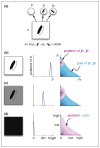Statistically optimal perception and learning: from behavior to neural representations
- PMID: 20153683
- PMCID: PMC2939867
- DOI: 10.1016/j.tics.2010.01.003
Statistically optimal perception and learning: from behavior to neural representations
Abstract
Human perception has recently been characterized as statistical inference based on noisy and ambiguous sensory inputs. Moreover, suitable neural representations of uncertainty have been identified that could underlie such probabilistic computations. In this review, we argue that learning an internal model of the sensory environment is another key aspect of the same statistical inference procedure and thus perception and learning need to be treated jointly. We review evidence for statistically optimal learning in humans and animals, and re-evaluate possible neural representations of uncertainty based on their potential to support statistically optimal learning. We propose that spontaneous activity can have a functional role in such representations leading to a new, sampling-based, framework of how the cortex represents information and uncertainty.
Copyright 2010 Elsevier Ltd. All rights reserved.
Figures







Similar articles
-
Perceptual inference.Neurosci Biobehav Rev. 2015 Aug;55:375-92. doi: 10.1016/j.neubiorev.2015.05.001. Epub 2015 May 11. Neurosci Biobehav Rev. 2015. PMID: 25976632 Review.
-
Probabilistic brains: knowns and unknowns.Nat Neurosci. 2013 Sep;16(9):1170-8. doi: 10.1038/nn.3495. Epub 2013 Aug 18. Nat Neurosci. 2013. PMID: 23955561 Free PMC article. Review.
-
Probabilistic population codes and the exponential family of distributions.Prog Brain Res. 2007;165:509-19. doi: 10.1016/S0079-6123(06)65032-2. Prog Brain Res. 2007. PMID: 17925267 Review.
-
Neural Variability and Sampling-Based Probabilistic Representations in the Visual Cortex.Neuron. 2016 Oct 19;92(2):530-543. doi: 10.1016/j.neuron.2016.09.038. Neuron. 2016. PMID: 27764674 Free PMC article.
-
Where's the Noise? Key Features of Spontaneous Activity and Neural Variability Arise through Learning in a Deterministic Network.PLoS Comput Biol. 2015 Dec 29;11(12):e1004640. doi: 10.1371/journal.pcbi.1004640. eCollection 2015 Dec. PLoS Comput Biol. 2015. PMID: 26714277 Free PMC article.
Cited by
-
Learning to integrate parts for whole through correlated neural variability.PLoS Comput Biol. 2024 Sep 3;20(9):e1012401. doi: 10.1371/journal.pcbi.1012401. eCollection 2024 Sep. PLoS Comput Biol. 2024. PMID: 39226329 Free PMC article.
-
Sampling motion trajectories during hippocampal theta sequences.Elife. 2022 Nov 8;11:e74058. doi: 10.7554/eLife.74058. Elife. 2022. PMID: 36346218 Free PMC article.
-
Probabilistic inference in general graphical models through sampling in stochastic networks of spiking neurons.PLoS Comput Biol. 2011 Dec;7(12):e1002294. doi: 10.1371/journal.pcbi.1002294. Epub 2011 Dec 15. PLoS Comput Biol. 2011. PMID: 22219717 Free PMC article.
-
Analysis of the Effect of Musical Stimulation on Cortical Auditory Evoked Potentials.Int Arch Otorhinolaryngol. 2019 Jan;23(1):31-35. doi: 10.1055/s-0038-1651507. Epub 2018 Jul 25. Int Arch Otorhinolaryngol. 2019. PMID: 30647781 Free PMC article.
-
Separable gain control of ongoing and evoked activity in the visual cortex by serotonergic input.Elife. 2020 Apr 7;9:e53552. doi: 10.7554/eLife.53552. Elife. 2020. PMID: 32252889 Free PMC article.
References
-
- Barlow HB. Possible principles underlying the transformations of sensory messages. In: Rosenblith W, editor. Sensory Communication. MIT Press; 1961. pp. 217–234.
-
- Smith JD. The study of animal metacognition. Trends Cogn Sci. 2009;13:389–396. - PubMed
-
- Pouget A, et al. Inference and computation with population codes. Annu Rev Neurosci. 2004;26:381–410. - PubMed
-
- Helmholtz HV. Treatise on Physiological Optics. Optical Society of America; 1925.
Publication types
MeSH terms
Grants and funding
LinkOut - more resources
Full Text Sources
Other Literature Sources

